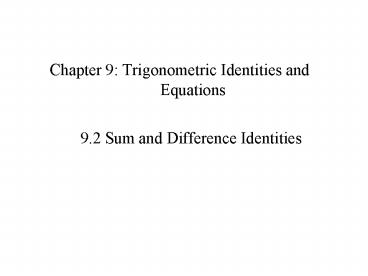Chapter 9: Trigonometric Identities and Equations - PowerPoint PPT Presentation
1 / 12
Title:
Chapter 9: Trigonometric Identities and Equations
Description:
Since SOQ = PORchords PR and SQ are equal. 9.2 Sum and Difference Identities. By the distance formula, chords PR = SQ, Simplifying this equation and using the identity ... – PowerPoint PPT presentation
Number of Views:122
Avg rating:3.0/5.0
Title: Chapter 9: Trigonometric Identities and Equations
1
Chapter 9 Trigonometric Identities and
Equations
- 9.2 Sum and Difference Identities
2
9.2 Sum and Difference Identities
- Derive the identity for cos(A B). Let angles A
and B be angles in standard position on a unit
circle with B lt A and S and Q be the points on
the terminal sides of angels A and B,
respectively.
Q has coordinates (cos B, sin B). S has
coordinates (cos A, sin A). R has coordinates
(cos (A B), sin (A B)). Angle SOQ equals A
B. Since ?SOQ ?POR, chords PR and SQ are equal.
3
9.2 Sum and Difference Identities
- By the distance formula, chords PR SQ,
- Simplifying this equation and using the identity
- sin² x cos² x 1, we can rewrite the equation
as - cos(A B) cos A cos B sin A sin B.
4
9.2 Sum and Difference Identities
- To find cos(A B), rewrite A B as A ( B)
and use the identity for cos (A B).
Cosine of a Sum Or Difference cos(A B) cos A
cos B sin A sin B cos(A B) cos A cos B
sin A sin B
5
9.2 Finding Exact Cosine Values
- Example Find the exact value of the following.
- cos 15
- cos
(or 60 45)
6
9.2 Sine of a Sum or Difference
- Using the cofunction relationship and letting
- ? A B,
- Now write sin(A B) as sin(A ( B)) and use
the identity for sin(A B).
7
9.2 Sine of a Sum or Difference
Sine of a Sum or Difference sin(A B) sin A
cos B cos A sin B sin(A B) sin A cos B
cos A sin B
8
9.2 Tangent of a Sum or Difference
- Using the identities for sin(A B), cos(A B),
and tan(B) tan B, we can derive the
identities for the tangent of a sum or difference.
Tangent of a Sum or Difference
9
9.2 Example Using Sine and Tangent Sum or
Difference Formulas
- Example Find the exact value of the following.
- sin 75
- tan
- sin 40 cos 160 cos 40 sin 160
- Solution
- (a)
10
9.2 Example Using Sine and Tangent Sum or
Difference Formulas
- (b)
- (c) sin 40 cos 160 cos 40 sin 160 sin(40
160) - sin(120)
Rationalize the denominator and simplify.
11
9.2 Finding Function Values and the Quadrant of
A B
- Example Suppose that A and B are angles in
standard - position, with
- Find each of the following.
- sin(A B) (b) tan (A B) (c) the quadrant
of - A B
- Solution
- (a)
Since cos A lt 0 in Quadrant II.
12
9.2 Finding Function Values and the Quadrant of
A B
- (b) Use the values of sine and cosine from part
(a) to - get
- (c) From the results of parts (a) and (b), we
find that - sin(A B) is positive and tan(A B) is
also - positive. Therefore, A B must be in
quadrant I.































